Creepy, crawly, and sometimes slimy, insects can destroy a garden. While some gardeners have great luck and have not had to fight pests extensively, others have not been so fortunate. I was among the previous group until this summer. Although I did not have to engage in all out battle with the pests.
While deadheading my Nicotiana sanderae plants, I noticed fuzzy white patches on 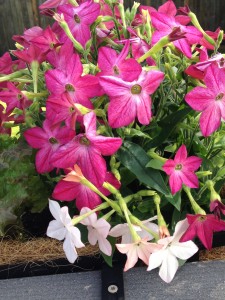 the leaves and a lot of white spots on the petals. I quickly swished all the white fuzzy bugs on the leaves. I was not quite sure what they were but thought they might be mealybugs because of their fuzzy, white characteristic. Next, I pruned all of the flower heads with the white spots. As the plants have grown, I have noticed a tendency for some of the flowers to turn white over the course of their growth. So, I do not believe the white spots on the petals to be associated with the insects.
the leaves and a lot of white spots on the petals. I quickly swished all the white fuzzy bugs on the leaves. I was not quite sure what they were but thought they might be mealybugs because of their fuzzy, white characteristic. Next, I pruned all of the flower heads with the white spots. As the plants have grown, I have noticed a tendency for some of the flowers to turn white over the course of their growth. So, I do not believe the white spots on the petals to be associated with the insects.
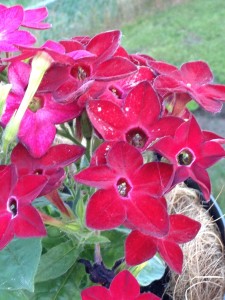
Finding the pests on the Nicotiana sanderae plants piqued my curiosity as to whether my other plants had pests on them. I found aphids on my cucumbers, tomatoes, forget-me-nots, luffa gourds, and peppers.
I promptly squished as many of the 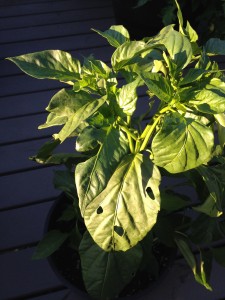 bugs as I could find. Although one of the peppers had holes in its leaves, a large infestation did not occur.
bugs as I could find. Although one of the peppers had holes in its leaves, a large infestation did not occur.
Unsure of what the fuzzy, white insects were, I emailed the Anchorage Cooperative Extension’s Integrated Pest Management Team pictures of the bugs. Jessie Moan, the Statewide IPM Technician, believed the fuzzy white insects to be castings from the aphids as they mature. Moan’s recommendation was for me to bring a sample of the bugs to the Anchorage office for positive identification. However, I had already smushed all of the evidence.
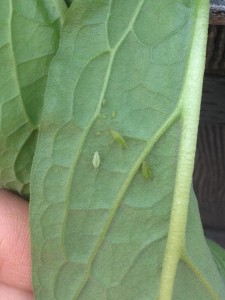

Aside from squishing all the aphids, another method of combating an infestation is with companion planting. Aphids, nematodes, cabbage worms, spider mites, among others have been known to be repelled by various plants. For a list of some plants visit the University of Illinois Extension’s website to learn about using plants to control pests and Wikipedia: List of pest-repelling plants.
When companion planting, be aware of planting invasive species. In the UAF Cooperative Extension Service’s publication, Don’t Plant a Problem, it states chives (Allium schoenoprasum), catnip (Nepeta cataria), St. John’s Wort, comfrey (Symphytum officinale), and mint (Mentha sp.) have potential to be invasive in Alaska. Another resource to consult on invasive plants is the USDA Forest Service’s publication, Selected Invasive Plants of Alaska.
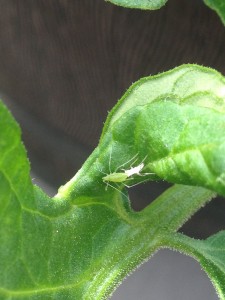
For more information about companion planting and some common groupings view the following websites: Wikipedia: List of companion plants, Cornell University: Companion Planting, Burpee: Companion Planting Guide, ATTRA: Companion Planting: Basic Concepts & Resources
Another way to keep pests at bay is mechanical control. That includes swishing the pests as you find them. If there are not many insects, this is an effective way to control the bugs. The bugs can be moved from the plants as well. This would be an effective approach to slugs on a plant. You can also spray the plants with water. This can often knock off aphids and others off the plant. Scale insects can be scraped off with a fingernail. In addition, a plant can be pruned to remove the nuisance organism.
Lastly, chemical control could be used to fight aphids and other garden pests. When using chemicals, be sure to use the right chemical for the right pest and the right dosage. Some chemicals, will not only kill the pests, but will also kill beneficials such as honey bees, butterflies and lady beetles.
Resources:
i like it… thank yu….